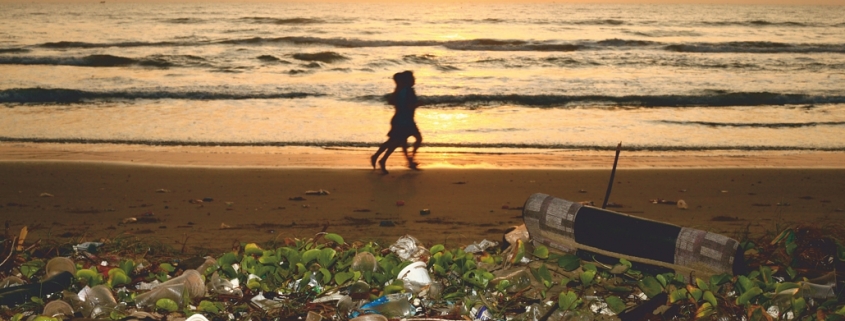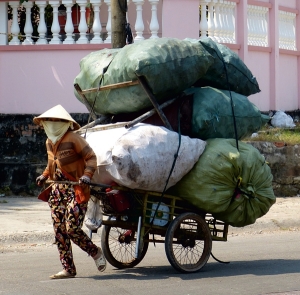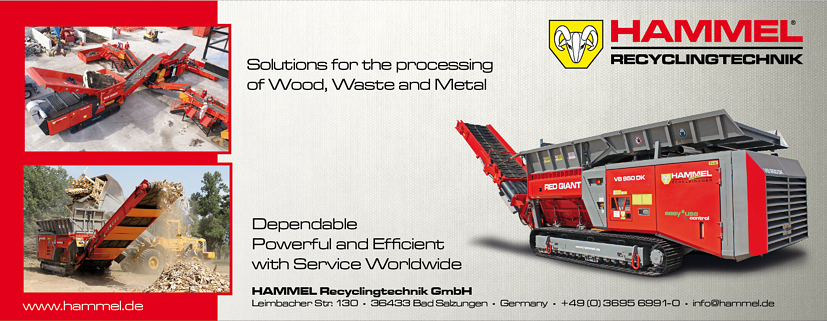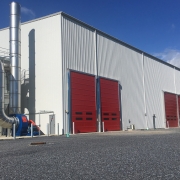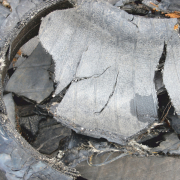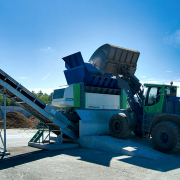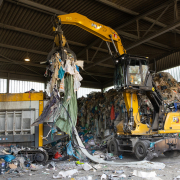Waste Management in Vietnam: The Race Is on
In 2015, Vietnam was number four out of five countries that dump more plastic into the oceans than the rest of the world combined. To attribute the country “drowning in waste” was not witty, but accurate. Progress in the waste treatment technology during the last years delivers what a study called “a proof for hope of waste management”.
In May 2018, the Netherlands’ Ministry of Foreign Affairs, CREM and Partners for Innovation published a comprehensive scoping study on the circular economy. The statistics offered that the annual Vietnamese waste production comprised more than 27.8 million tons consisting of 46 percent from municipal sources, the remainder delivered from agriculture and industry. The five biggest cities – Hanoi, Ho Chi Minh City (HCM City, former Saigon), Haiphong, Da Nang and Can Tho – are responsible for about 70 percent of the total waste generation. The municipal solid waste contains 60 to 70 percent of biodegradable residues by wet weight.
Landfilling quota up to 85 percent
According to the German Society for International Cooperation (GIZ), at the same time, the Vietnamese collection coverage ranged from 40 to 85 percent differing between rural and urban areas, with rates of 95 percent in Hanoi and Ho Chi Minh City. Waste diverted from disposal amounted to 44 percent without precise information about recycling and reuse, composting and utilization of energy recovery from waste or biogas. The resulting disposal share accounted for 56 percent. However, a contemporary study concerning the waste market assumes that even about 85 percent of the waste generated in Vietnam is landfilled without treatment at sites, 80 percent of them being unsanitary. According to incomplete statistics from the national Ministry of Natural Resources and Environment (MONRE), there are 450 landfills in Vietnam but only about 120 following proper sanitary regulations.
In January 2020, an article published by the World Economic Forum described the Vietnamese waste situation as “a combination of rising consumption and poor national waste management”. Waste generated between 2004 and 2015 increased from 15.6 million tons to 27.8 million tons annually. Furthermore, estimations assume an increase of municipal solid waste quantity by 10 to 16 percent every year, so that the quantity per capita will quadruple in the next 15 years. 50 to 70 percent of the waste in urban areas could be recycled, but only a limited amount is handled that way at present. Hoang Duong Tung, Deputy Director of the Environment Department at the MONRE, complained that – despite some waste recycling systems installed – infrastructure and effectiveness “could not keep up with the demand”.
Recycling handled by the informal sector
No wonder, as from 1990 to 2015 the plastic consumption per capita rose from 3.8 kilograms (kg) to 41 kg – an increase of 10 percent year-on-year. Especially plastic is of “growing concern”, as the country is “drowning in waste”, so that the tourism sector says “NO to plastic waste”, online magazine headlines suggest. In Hanoi and Ho Chi Minh City about 80 tons of plastic and plastic bags are discharged daily, and in Hanoi alone, plastic accounts for seven to eight percent of the 4,000 to 5,000 tons of daily waste, Deputy Minister of Natural Resources and Environment Vo Tuan Nhan is quoted. But until recently, most of the plastic material recycled in Vietnam was imported from other countries like China and – after the Chinese ban of scrap imports – the United States. Indeed, Vietnam stopped issuing plastic recycling import licenses in June 2018 and planned to stop US scrap plastic imports in 2025. But the effect was a boosted demand for recyclable domestic plastic waste and an increased import of US plastic scrap in 2018, the research experts of Mordor Intelligence found out. And most of the recycling – usually collected by waste scavengers – is performed by manufacture handicrafts by the informal sector: either informal family businesses or small-scale enterprises specialized in recycling discarded plastic (or other waste materials).
Small profit margins
“Recycling technologies in craft villages are mainly manual and outdated, causing serious environmental pollution. Besides, wastes from craft villages are not treated but dumped directly into the environment with municipal wastes and taken to landfills,” a comprehensive paper conducted by the Vietnam Business Council for Sustainable Development, the Vietnam Chamber of Commerce and Industry and the United States Business Council for Sustainable Development explained in summer 2019. A scientific analysis of recycling structures for electro(nic) waste shows a comparable infrastructure of basic and obsolete technologies: manual dismantling works, manual and experience-based metal recycling processes, single extraction of copper and gold, no recovery of precious metals or rare earth elements. In this narrow system, there is no chance for foreign suppliers to achieve market share, especially as no financial resources for technological improvement are available. German Trade and Invest spoke in May 2018 of about 120 enterprises possessing licenses for the disposal of industry, medical and hazardous waste, but also mentioned hard market competition and small profit margins.
Regulations assigned to different actors
The Vietnamese government adopted several legislative requirements for waste treatment. Major regulations are mentioned in Decision 31/2014/QD-TTg regarding the development of power generation projects using solid waste, Circular 32/2015/TT-BCT concerning grid-tied generation projects using solid wastes, Decree 38/2015/NDCP on the management of waste and discarded materials, Decree 174/2007/ND-CP on environmental protection fee of solid waste, and Decree 118/2015/ND-CP dealing with investment incentives and schemes in various waste treatment sectors. The Law of Environmental Protection delivers modern legal conditions for a sustainable waste treatment business, and a National Waste Management Strategy provides a detailed framework for building a circular economy focusing on the complete waste collection by 2025. The aim is a collection rate for municipal waste of 90 percent with a recycling share of 85 percent and for industrial waste of 90 percent and 80 percent respectively. Furthermore, the Prime Minister issued a national action plan on maritime plastic waste management to reduce 75 percent of plastic debris by 2030. But – as the before mentioned scoping study expresses – “institutional arrangement of solid waste management in Vietnam is complex and involves many Ministries in the system”. The online-magazine VietNamNet Global stated in Mai 2019 that solid waste management in Vietnam has been “assigned to different ministries and agencies, which are inconsistent from central to local levels” and is still exposing a lot of shortcomings.
Only 36 incinerators and composting sites
In fact, a GIZ-list of treatment sites in 2018 included merely 36 treatment facilities: five incinerators, 12 compost sites and 18 composting and incineration sites without energy recovery. The only waste-to-energy plant worked since 2016. According to foreign investors assistant firm Vietnam Briefing, the country’s installed capacity for energy recovery from biomass and solid wastes in June 2018 reached 352 MW (megawatt) and 2.4 MW respectively, while the potential from that material was around 2,000 MW and 320 MW respectively: The Vietnamese energy demand, however, ranges from 10 percent by 2020 and eight percent by 2030, with a fourfold increase of electricity consumption in 2030 compared to 2014.
Incentives for local and external investors
The shortfall in capacity became more serious so that the big cities were forced to react. The capital city of Hanoi, for example, inaugurated its first industrial waste-to-energy facility in April 2017, with a waste treatment capacity of 75 tons per day and a power generation capability of 1.93 MW. The equipment came from Japan’s Hitachi Zosen Corporation, and 22.5 from 29 million US-Dollar investments were raised by a Japanese governmental organization. In December 2018, a waste-to-energy factory with an investment of 47 million US-Dollar was inaugurated in Thoi Lai district of Can Tho; to be constructed by China Everbright International, it is expected to help address the solid waste pollution the Mekong Delta city is recently facing. In Ho Chi Minh City, “sufficient funds are available for transport and treatment” of municipal waste and “hundreds of billions of dong per year” were invested for treatment, according to VUFO-NGO Resource Centre in HCM City. Similarly, a solid waste management expert from the HCM City Department of Natural Resources in September 2019 gave an account that the city government had offered incentives to local and foreign investors to invest in waste treatment projects. At the same time, the planning of a 400-million US-Dollar waste-to-energy plant with the first phase capacity of 2,000 tons per day became public. Additionally, two months later, HCM City started to work on its first industrial and hazardous waste treatment and recycling plant, officially operational in September 2021, handling 500 tons per day and turning 70 to 90 percent of the waste into materials and products. Until then, the city supposedly ran 13 licensed, but small hazardous waste treatment facilities with a limited capacity of 250 tons per day and untreated waste volumes delivered to other localities.
Number of foreign competitors growing
Other foreign competitors entered the market. In February 2017, Australia’s Trisun Green Energy Co secured approval to build a 520 million US-Dollar waste treatment plant outside Ho Chi Minh City. The facility’s application of a plasma gasification technology was designed for burning 3,000 tons of material, i.e. about 40 percent of the city’s volume. More than that, the company set a goal of building up between 12 to 20 electricity-generating waste treatment plants capable of replacing coal-fired plants in Vietnam in the next five to ten years, the firm said on its website. Finnish waste technology suppliers became interested too: In July 2018, Doranova Oy planned two landfill gas plant projects in HCM City; Watrec launched a waste to energy project in Hanoi and started a technical consultancy related to a large scale waste-to-energy project in HCM City; Valmet was concerned in cooperation and technology transfer with Vietnamese partners; and BioGTS kept an eye on a biogas technology application in waste and wastewater treatment in Dong Thap province. In October 2018, Japan-based industrial technology firm Hitachi Zosen Corporation’s subsidiary, Hitachi Zosen Vietnam Co. Ltd., declared to expand its waste-to-energy operations in Vietnam and the development of plant constructions in the capital of Hanoi and neighboring cities in Northern Vietnam. Furthermore, in June 2019, nine companies even joined hands for a packaging recycling alliance: Coca-Cola Vietnam, FrieslandCampina, La Vie, Nestlé Vietnam, NutiFood, Suntory PepsiCo Vietnam, Tetra Pak Vietnam, TH Group and URC Vietnam teamed up and launched the Packaging Recycling Organization Vietnam (PRO Vietnam) in HCM City. It seems that – as Mordor Intelligence expressed – “the number of foreign competitors is constantly growing and only quality is often not enough to sustain as a long-term business partner.”
International associates wanted
The majority of the companies in Vietnam’s solid waste management industry are state-owned, while foreign countries or large, partly multinational companies with Vietnamese subsidiaries provide the technology. However, neither central nor local governments dispose of financial means to fund state-of-the-art and sustainable waste treatment projects. So, they are looking at foreign associates to tackle waste. For example, in 2018, the World Bank gave a credit of 202 million US-Dollar to Vietnam for a renewable energy development project, while the Asian Development Bank designed a waste-to-energy scheme to increase the energetic usage of waste. At a working session with representatives of the American Chamber of Commerce in Vietnam, an official speaker, for instance, expressed his hope that “the US business community will take an active part in investing in and providing technical support for the city”; representatives of the US firms answered that HCM City is very attractive to many investors. Swedish Ambassador to Vietnam, Ann Mawe, is cited with the words: “Sweden would happily share its experiences (on the circular economy) with Vietnam.” And in their scoping study, the Netherland’s Ministry of Foreign Affairs, CREM and Partners for Innovation phrased a roadmap – interesting for Dutch and Vietnamese stakeholders – to benefit from the opportunities the transition towards a circular economy could offer in Vietnam: “Potential partners involved are identified, as well as support and instruments by the Dutch government that could support the action.”
“Consider Vietnam!”
At the end of 2017, experts realized a lack of favorable investment conditions for foreign investors, who were first of all waiting for new public-private partnership regulations that were not fully developed even in Mai 2018. Additionally, to increase investments in new plants or capacity expansion of existing facilities, the government at that time was obliged to support the domestic firms financially as it takes time to recover capital investments in the sector, Vietnam Briefing stated. The waste-to-energy sector in Vietnam, without doubt, holds a lot of potential. But Nguyễn Ngọc Lý, Director of the Center for Environment and Community Research, is skeptical. She is quoted with the words: “Vietnam has been struggling against increased solid waste discharge into the environment, while treatment facilities are unlikely to catch up for decades.” So, the country is well advised to tackle the issue head-on and invite interested parties with the welcome of the Embassy of Denmark, Vietnam: “Looking for a market with an increasing need to invest in new waste management technologies? Consider Vietnam!”
(GR22020, Page 24, Photo: Sergei Tokmakov / Pixabay.com)

